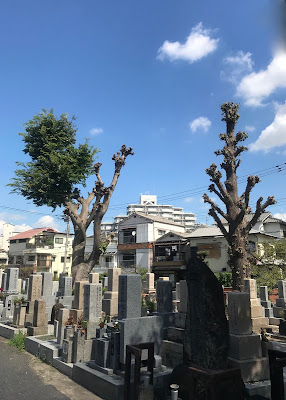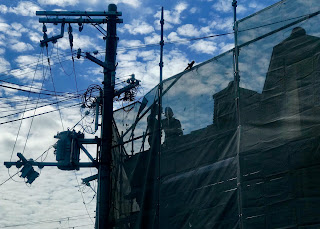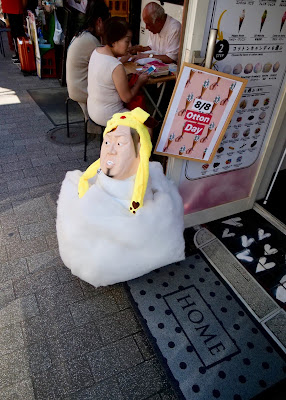Explorations and experiments in visual representations - multimodality, sensory ethnography, reflexivity, autoethnographic vignettes, ethnographic photography and ba...

Thursday, September 26, 2019
Wednesday, September 25, 2019
Wednesday, September 18, 2019
Post-Lecture and a shot of "double inspiration porn"
The talk at the Kyoto Asian Studies Group went very well last night. There was a good crowd with several familiar faces. The lecture was one hour and five minutes (thanks to my DWJ students for suggestions on how to cut an earlier and longer version...) and there was almost an hour of interesting and important discussion afterwards. It was a great time. Thanks to KAS and everyone who attended!
In a congratulatory message my former professor and colleague sent me this:
Those who came last night will immediately get it. For those who couldn't attend, it is related to the following quote used in the presentation (and ensuing discussion).
I used to watch videos of abandoned dogs finding their forever homes and deaf people being able to hear for the first time to help soothe me on a bad day.
"Inspiration porn misrepresents deaf people, culture"
BY BRITTANY CRUZ-FEJERAN
The Southwestern College Sun, 05/13/2019
url: https://www.theswcsun.com/inspiration-porn-misrepresents-deaf-people-culture/
See the video before and prepare to be double inspired! (Thanks to EK for the message and screen shot.)
See also: http://visualanthropologyofjapan.blogspot.com/2019/09/announcement-kyoto-asian-studies-group.html
In a congratulatory message my former professor and colleague sent me this:
Those who came last night will immediately get it. For those who couldn't attend, it is related to the following quote used in the presentation (and ensuing discussion).
I used to watch videos of abandoned dogs finding their forever homes and deaf people being able to hear for the first time to help soothe me on a bad day.
"Inspiration porn misrepresents deaf people, culture"
BY BRITTANY CRUZ-FEJERAN
The Southwestern College Sun, 05/13/2019
url: https://www.theswcsun.com/inspiration-porn-misrepresents-deaf-people-culture/
See the video before and prepare to be double inspired! (Thanks to EK for the message and screen shot.)
See also: http://visualanthropologyofjapan.blogspot.com/2019/09/announcement-kyoto-asian-studies-group.html
Tuesday, September 10, 2019
Announcement: Kyoto Asian Studies Group Meeting on September 17, 2019 - “Inspiration Porn and Representations of Deaf People in Japan”
Announcement from H-Japan, September 9, 2019:
The speaker for the September meeting of the Kyoto Asian Studies Group is Steven C. Fedorowicz, who will present “Inspiration Porn and Representations of Deaf People in Japan” (see abstract below).
The talk will be held on Tuesday, September 17th, 18:00-20:00 in Room 212 of the Fusokan on the Doshisha University Campus (see link below for access information).
Abstract
Inspiration Porn and Representations of Deaf People in Japan
This presentation examines so-called "inspiration porn" -- the idealization of disabled people doing everyday tasks (e.g. riding a train, having a job) or for achievements having nothing to do with their particular disability (e.g. deaf athletes) -- and its relationship to disability identities with a focus on deaf people in Japan. Cross-cultural examples, observations and perspectives will be discussed to set up an exploration of how disabled and deaf people are portrayed in various media. Japanese deaf people are often critical of the representations of deaf protagonists and characters in popular television dramas and movies. Such representations create strong but inaccurate images of deafness and sign language that ultimately serve to perpetuate deficit models of disability. On the other hand, representations of disabled/deaf people themselves challenge and add to a social welfare discourse leading to (re)evaluations of societal norms and attitudes towards disability with the ultimate goal of a barrier-free environment. This presentation will also discuss how the Law to Eliminate Discrimination against People with Disabilities (April 2016), Sagamihara Care Home Massacre (July 26, 2016) and upcoming Tokyo 2020 Paralympics have changed and influenced disability discourses and representations.
Steven C. Fedorowicz is an Associate Professor of Anthropology in the Asian Studies Program, Kansai Gaidai University.
Sponsored by the Kyoto Consortium for Japanese Studies. For access information see:
http://www.doshisha.ac.jp/en/information/campus/imadegawa/imadegawa.html
Please refrain from bringing food or drinks into the meeting room.
Contact: Niels van Steenpaal, nielsvansteenpaal@hotmail.com
About the Kyoto Asian Studies Group:
The KASG is a long-standing Kyoto-based research network that hosts monthly research presentations by experts from various Asian Studies fields. Emphasizing long Q&A sessions, we aim to provide an informal atmosphere in which scholars can freely exchange ideas concerning both finished and in-progress research. Admission is free, and we always welcome new members and presenters.
Friday, September 6, 2019
"Forgotten films from '64 shed light on Paralympic evolution in Japan"
Photo and text borrowed from The Japan Times, 9/5/19.
Two long-forgotten films offering a rare glimpse into the staging of the 1964 Tokyo Paralympics and the conditions that were faced by disabled people in Japan at the time are being aired with about a year to go before the 2020 Games.
Gathering dust for about five decades, the films capture the atmosphere of postwar society in 1964, and the involvement of then-Crown Prince Akihito and Crown Princess Michiko in the fledgling sports movement.
The 1964 Paralympics were officially called the “International Games for the Physically Handicapped,” but the Tokyo event marked the first time the term “paralympics” came into wide, albeit then unofficial, use. It is now considered by the International Paralympic Committee to be the second Paralympics after the 1960 Rome Games, which were also called the Paraplegic Olympics.
A few of the Japanese athletes were former servicemen, and members of the Imperial family visited and watched the competitions, according to Journal of the Paralympic Research Group by the Nippon Foundation Paralympic Support Center. Many of the foreign athletes were also ex-servicemen.
One of the films, the title of which can be translated as “Tokyo Paralympics, Festival of Love and Glory” (“Tokyo Paralympic Ai to Eiko no Saiten”), had been “buried in the company’s massive archives,” Satoru Nokuo, associate general manager at distributor Kadokawa Corp., said at a screening at Sophia University in July.
The other film, “Record of the 1964 Tokyo Paralympic Games” (“1964-nen Tokyo Paralympic Taikai Kiroku Eiga”), was found in a warehouse of the Japanese Para-Sports Association, according to Tetsuya Takeuchi, a senior commentator at NHK who took part in the screenings.
Through interviews and other means, the 63-minute and 45-minute films depict how people with disabilities in Japan regained their sense of worth by playing sports and interacting with foreign athletes who had endured similar struggles.
The former was directed by cinematographer Kimio Watanabe and the latter by the NHK Public Welfare Organization.
The films also cast light on the differences between Japanese athletes, many of whom lived in institutions at the time, and their foreign counterparts, who in many cases were active in their communities.
For NHK’s Takeuchi, who uses a wheelchair, the films are a reminder about how much still needs to be done to improve the lives of disabled people in Japan. While transport access and other issues have improved, the situation “has not really changed in any significant way. People with disabilities still face challenges in finding marriage partners and jobs,” he said.
Compared with today, the events of 1964 were seen, especially in Japan, as a way to provide physical rehabilitation rather than competition.
“I’ve noticed the word rehabilitation was mentioned many times (in the films),” archer Tomohiro Ueyama said at the screening for the NHK film. Ueyama competed in the 2016 Rio Games and is expected to compete in 2020. “But it’s different now, and I am hoping people will enjoy the Paralympic Games as a sports event in Tokyo rather than rehabilitation.”
According to an official 1964 Paralympics report, the two films are among six independently produced records of the event; the other four are missing. No official filming of the Paralympics was conducted due to a lack of funding, the report said.
“Thanks to the two surviving films, we are able to see what really happened in 1964,” said Fumio Morooka, a professor emeritus at Sophia University who moderated the talks at the screenings. He said it was important to keep a visual record of such events.
“As no official announcement has been made yet on the film production to record the upcoming Tokyo Paralympics … I truly hope the public and private sectors will cooperate to produce a visual record that can pass on the legacy of the games to future generations,” Morooka said.
Andrew Parsons, the president of the International Paralympic Committee, said in a statement that he was pleased the original 1964 Tokyo Paralympic Games film had been found and stressed their “lasting legacy” in both Japan and around the world.
“Since 1964 we have seen the Paralympic movement grow and grow, taking leaps and bounds not just for the Paralympians, but also for society as a whole,” he said.
Source: https://www.japantimes.co.jp/news/2019/09/05/national/forgotten-films-64-shed-light-paralympic-evolution-japan/?fbclid=IwAR26G_K64gFCdy4MHQTOWMMgyaz5GmLAL2btEU_G-PbNBPtarDUy5O5pRAc#
Sunday, September 1, 2019
Yokohama Chinatown: Selected Shots (and the end of the Tokyo trip arc...)
Another bright spot on my recent Tokyo trip - getting out of Tokyo and checking out Yokohama Chinatown for the first time. Don't get me wrong, I don't hate Tokyo (I am not a hater...). But it is not one of my favorite cities. There's a lot of interesting and good places to go to in Tokyo. But I have always needed such a goal. Wandering around Tokyo has never really worked for me (as it has in other big cities). And I don't know how to explain it, but there was a sense of relief as my train left Tokyo and entered Yokohama...
If you haven't seen the whole arc, please do:
ANNOUNCEMENT:「Tachinomiya: Photo Exhibition as Post-Fieldwork Encounter」- Society for East Asian Anthropology Regional Conference 2019 in Tokyo
Post-Conference Blues -and- Dealing with the Best and Worst of Tokyo...
FUJIYA Tenugui (hand towel) Shop - Art/Encyclopedia
Izakaya 「Daruma」in Monzen-Nakacho
Tsukiji Fish Market Circa 2011 (special prequel)
The New Toyosu Fish Market in Tokyo - still the biggest in the world!
A Serendipitous, Quick Shot From My Taxi: New National Stadium for Tokyo 2020 Olympics (right next to Meiji Jingu Stadium)
(A bright spot in Tokyo...): Meiji Jingu Stadium - selected shots...
Barrier-free/Handicapped Restrooms Have Become Luxurious Uber-Universal Design... at least at this certain hotel somewhere in Tokyo
Shinjuku-Kabuki-cho: Selected Shots
And now for the Yokohama Chinatown shots:
And then my camera broke again... (The lens doesn't seem to want to connect to the camera body when it gets too hot - and Yokohama was hot!) Anyway, I only had a short time in Yokohama. I look forward to going there again.
Subscribe to:
Posts (Atom)


































